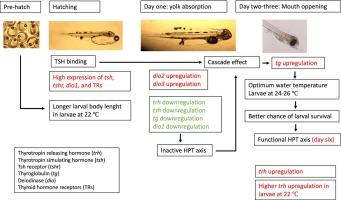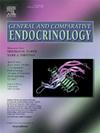Gene expression in the hypothalamic-pituitary-thyroid axis in Seriola rivoliana early larvae development at different temperatures
IF 1.7
3区 医学
Q3 ENDOCRINOLOGY & METABOLISM
引用次数: 0
Abstract
We analyzed the expression of genes involved in the hypothalamic-pituitary-thyroid axis (HPT-axis) in the longfin yellowtail Seriola rivoliana early larva, including temperature effects (22, 26 and 28 °C) and days of development (day one, day two, and day six after hatching). We aimed to determine if egg and larval incubation at different temperatures could disrupt this critical endocrine axis, which, in an aquaculture context, it could provoke mortality during early metamorphosis. There was a significant interaction between temperature and developmental timing on the relative expression of thyrotropin releasing hormone (trh). Larvae at 22 °C was the longest and increased more trh expression than larvae at higher temperatures. Interestingly, thyrotropin stimulating hormone (tsh) was highly expressed after hatching. Subsequently, it was downregulated at any temperature at least until day four, suggesting a temporal inhibition of the HPT axis. Therefore, we suggest that tsh-binding (tshr) to follicles should have occurred from hatching, creating a further “cascade effect” of upregulation of larval thyroglobulin (tg) from day two in a temperature-dependent manner. Consequently, new thyroid hormones should have been produced after yolk sac absorption. The above may indicate a narrow window of larval survival, where the larval transition from endogenous to exogenous feeding would depend on the correct timing to synthesize tg. Temperature significantly affected the expressions of deiodinase 1 (dio1-downregulated) and deiodinase 2 (dio2-upregulated) after hatching. The expressions of thyroid receptors alpha (trα) and beta (trβ) remained constant after hatching without significant effects of temperature and days of development. Then, the differential expression on day six showed that all HPT-axis transcripts increased their expressions as larvae developed, which suggested a functional HPT. Finally, there was no evidence that any temperature would disrupt the endocrine’s larval axis, which indicated that the longfin yellowtail has a wide temperature adaption. Nevertheless, based on tg upregulation, we suggest that larvae should be maintained around 25–26 °C after hatching for a better chance of survival and development.

下丘脑-垂体-甲状腺轴在不同温度下的基因表达
我们分析了长鳍大黄鱼(Seriola rivoliana)早期幼体的下丘脑-垂体-甲状腺轴(HPT轴)相关基因的表达,包括温度影响(22、26和28 °C)和发育天数(孵化后第1天、第2天和第6天)。我们的目的是确定在不同温度下孵化鱼卵和幼体是否会扰乱这一关键的内分泌轴,在水产养殖中,这可能会导致鱼类在早期变态过程中死亡。温度和发育时间对促甲状腺激素释放激素(trh)的相对表达有明显的交互作用。与温度较高的幼体相比,22 °C下的幼体发育时间最长,促甲状腺激素释放激素(trh)的表达量也增加得更多。有趣的是,促甲状腺激素(tsh)在孵化后表达量很高。随后,在任何温度下,至少到第四天,它的表达都会下降,这表明促甲状腺激素轴在时间上受到抑制。因此,我们认为tsh与卵泡的结合(tshr)应该在孵化后就开始了,并进一步产生了 "级联效应",即从第2天开始,幼虫甲状腺球蛋白(tg)以温度依赖的方式上调。因此,新的甲状腺激素应在卵黄囊吸收后产生。上述情况可能表明,幼虫的存活窗口很窄,幼虫从内源性摄食过渡到外源性摄食取决于合成tg的正确时机。温度对孵化后脱碘酶1(dio1下调)和脱碘酶2(dio2上调)的表达有明显影响。甲状腺受体α(trα)和β(trβ)的表达在孵化后保持稳定,不受温度和发育天数的显著影响。然后,第 6 天的差异表达表明,随着幼虫的发育,所有 HPT 轴转录本的表达量都有所增加,这表明 HPT 具有功能性。最后,没有证据表明任何温度都会破坏内分泌的幼体轴,这表明长鳍大黄鱼对温度有广泛的适应性。尽管如此,根据 tg 上调的情况,我们建议幼体孵化后应保持在 25-26 °C左右,以获得更好的存活和发育机会。
本文章由计算机程序翻译,如有差异,请以英文原文为准。
求助全文
约1分钟内获得全文
求助全文
来源期刊

General and comparative endocrinology
医学-内分泌学与代谢
CiteScore
5.60
自引率
7.40%
发文量
120
审稿时长
2 months
期刊介绍:
General and Comparative Endocrinology publishes articles concerned with the many complexities of vertebrate and invertebrate endocrine systems at the sub-molecular, molecular, cellular and organismal levels of analysis.
 求助内容:
求助内容: 应助结果提醒方式:
应助结果提醒方式:


